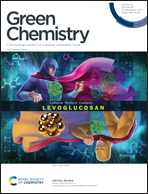Phosphorescent bio-based resin for digital light processing (DLP) 3D-printing†
Abstract
Since the advent of polymer-based 3D printing technology, the scientific community has directed great effort towards the development of new polymeric formulations that would allow applying this technique to various fields of application, ranging from materials science to tissue engineering. However, most of the available materials are nevertheless oil-based and cost-ineffective. This work presents a novel bio-based resin for stereolithographic DLP 3D printing formulated by mixing a photocurable polyester obtained from renewable resources (poly(1,3-propanediyl-co-glyceryl) itaconate-co-vanillate, PPGIV) with methacrylated citrate and itaconate crosslinkers (bis(HEMA) itaconate, BHI, and tris(HEMA) citrate, THC) and appropriate photopolymerization initiators, terminators and dyes. As a proof-of-concept, a photocurable ink is formulated with phosphorescent Ir(III) cyclometalated complexes and its potential applications have been demonstrated for both rigid and flexible structures.



 Please wait while we load your content...
Please wait while we load your content...